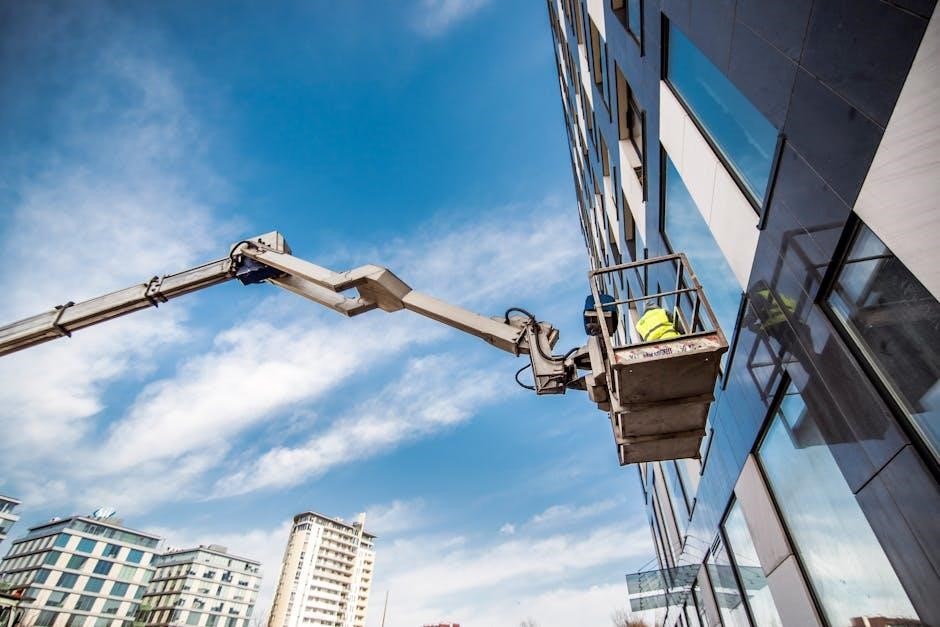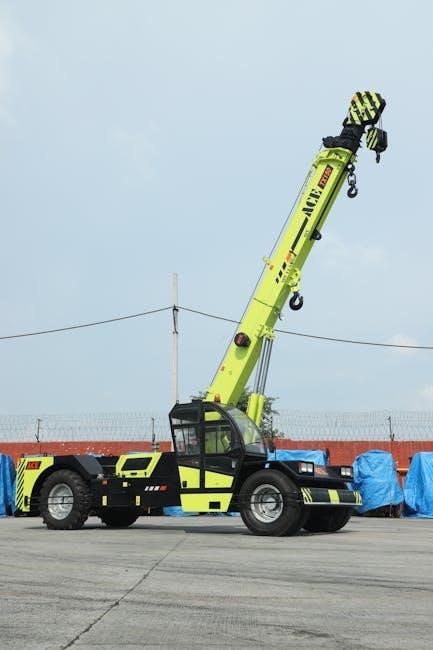manual crane
Manual cranes are simple machines used for lifting heavy loads with minimal effort and cost effectively in various industries and applications daily always.
Definition and Purpose
Manual cranes are defined as equipment used to lift and move heavy loads manually, providing a mechanical advantage to reduce the effort required. The primary purpose of manual cranes is to facilitate the safe and efficient handling of materials in various industries, including construction, manufacturing, and logistics. They are designed to be simple, reliable, and cost-effective, making them an essential tool for many applications. Manual cranes can be used in a variety of settings, from small workshops to large construction sites, and are often preferred for their ease of use and minimal maintenance requirements, making them a popular choice.

Types of Manual Cranes
Manual cranes include various types of equipment for lifting and moving heavy loads manually with ease and precision always safely daily.
Hand-Operated Cranes
Hand-operated cranes are a type of manual crane that uses human power to lift and move loads. These cranes are typically smaller and more portable than other types of cranes, making them ideal for use in confined spaces or for lifting smaller loads. They are often used in construction, manufacturing, and other industries where heavy lifting is required. Hand-operated cranes are also relatively inexpensive and easy to maintain, making them a popular choice for many businesses and individuals. They are a simple and effective way to lift and move heavy loads manually, and are an essential tool for many industries, providing a cost-effective solution.
Advantages of Manual Cranes
Manual cranes offer several benefits including cost-effectiveness and increased efficiency always daily.
Cost-Effectiveness
Manual cranes are a cost-effective solution for various industries, reducing labor costs and increasing efficiency. They require minimal investment and maintenance, making them an attractive option. With manual cranes, businesses can save on fuel and energy costs, as they are often powered by human effort. Additionally, manual cranes can be easily transported and stored, reducing transportation and storage costs. Overall, the cost-effectiveness of manual cranes makes them a popular choice for many applications, providing a reliable and affordable way to lift and move heavy loads, and helping businesses to stay within their budget and increase productivity.

Components of Manual Cranes
Manual cranes consist of frames and beams and other metal parts assembled together to form a structure always effectively.
Winches and Pulleys
Winches and pulleys are essential components of manual cranes, used to lift and move heavy loads with ease and precision always. These components work together to change the direction of force and motion, making it possible to lift heavy objects with minimal effort. The winch is used to wind the rope or cable, while the pulley is used to change the direction of the rope or cable, providing a mechanical advantage. This combination of winches and pulleys allows manual cranes to lift heavy loads safely and efficiently, making them a crucial part of various industries and applications every day always.

Applications of Manual Cranes
Manual cranes are used in construction and manufacturing industries for lifting heavy loads and equipment daily always with great efficiency and care.
Construction and Manufacturing
Manual cranes are widely used in construction and manufacturing industries for lifting and moving heavy materials and equipment. They are particularly useful in areas where space is limited or where heavy machinery cannot be used. Manual cranes are often used to lift and place building materials, such as bricks, blocks, and roofing tiles, and to move heavy equipment and machinery around construction sites. They are also used in manufacturing plants to lift and move heavy components and equipment, and to assist with assembly and production processes, increasing efficiency and productivity in these industries always.

Safety Considerations
Manual cranes require proper training and maintenance to ensure safe operation always daily.
Load Calculation and Operator Training
Manual crane operation requires careful load calculation to prevent accidents and ensure safe lifting. Operators must be trained to calculate loads accurately and operate the crane safely. This training includes understanding the crane’s capacity and limitations, as well as learning how to properly secure and balance loads. Proper training and load calculation are essential for preventing accidents and injuries. Operators must also be aware of their surroundings and take necessary precautions to avoid hazards. By following these guidelines, manual crane operators can ensure a safe and efficient lifting process, reducing the risk of accidents and injuries to themselves and others around them always.
Limitations of Manual Cranes
Manual cranes have limited lifting capacity and height restrictions always requiring careful planning and operation daily in various industries and applications effectively.
Load Capacity and Height Limitations
Manual cranes have limitations in terms of load capacity and height, requiring careful planning and operation to ensure safe and effective use always.
The load capacity of manual cranes is generally lower than that of powered cranes, and the height limitation can restrict their use in certain applications.
Understanding these limitations is crucial to selecting the right crane for a specific task and ensuring a successful outcome, manual cranes are used in various industries and applications daily effectively and efficiently.
Their limitations must be considered when planning and executing a lifting operation to avoid accidents and ensure a safe working environment always.
Comparison with Other Types of Cranes
Manual cranes differ from hydraulic and electric cranes in terms of operation and functionality always used effectively.
Hydraulic and Electric Cranes
Hydraulic and electric cranes are types of cranes that offer alternative solutions to manual cranes, with hydraulic cranes using fluid pressure to generate force and electric cranes utilizing electric motors for operation, both providing increased lifting capacity and efficiency, and are widely used in various industries, including construction and manufacturing, where heavy lifting is required, and they are often preferred over manual cranes due to their ability to handle heavier loads and provide more precise control, making them a popular choice for many applications, and they are also more versatile and can be used in a variety of settings.
